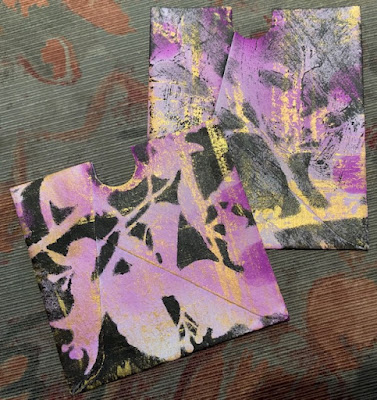Today I'm thrilled to show artwork from the hands of career artist Judi Kauffman. For today's focus, Judi used my 9" x 12" Fire Cherries Mask L879.
The idea for today's two featured projects came to her when she was gifted some business-size envelopes.
For both projects, Judi's first step was to seal flaps down, permanently closing each envelope that she wanted to use in this 2-pronged project.
Choosing to start with making bookmarks, Judi cut each sealed envelope as shown below.
 |
| Above: On the far left is a diagram of one finished bookmark being used on a book page. A photo of the same image is coming up below. |
Having finished with the cutting, Judi then inserted parchment paper into each triangular pocket before painting, to keep the matching sides of each triangular shape from sticking together during paint application. Below: A photo repeating what is shown at far left in the diagram above.
 |
| Above: Judi used part of my Fire Cherries Mask L879 (9" x 12") in creating this clever bookmark. |
Judi started with layered purple and teal stamping inks. Next, she used sponges to add still more layers with black acrylic paint and gold metallic acrylic paint.
Judi's photos:
Judi's second artful way to use her sealed envelopes was to create pockets and pocket cards. This time, Judi cut each envelope straight across ...
.... and, after again inserting parchment paper to keep the two sides from sticking together, she repeated the process of applying inks and paint in layers.
Afterward, Judi punched each pocket at the top with a tab punch. These half-holes make it easy for a viewer to see that art pockets have contents. This is important for artists who keep art journals, adding pockets to pages and filling them with small artsy oddments.
The topic of art pockets is covered in this YouTube video -- a helpful resource for people like me who aren't familiar with this area of mixed media art.
The two following photos show Judi's art pockets, ready to be used.
Who says Judi's kind of bookmark can't work as a pocket, too?
I have 6" x 6" greeting card blanks that were cut from gold metallic cardstock -- and they begged me to give this idea a spin.
In the two photos below, notice how well the gold cardstock backgrounds go with the gold metallic paint that Judi had used in creating two of her bookmarks--
Please be on the lookout -- another post featuring the gorgeous artwork of Judi Kauffman will be coming up!
Thanks for stopping by here today! To scroll thru the pages of my stencils and masks at StencilGirl Products.com, please start here.




















































